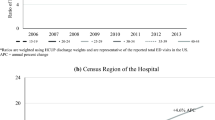Abstract
This study aimed to identify the incidence of adverse outcomes from ectopic pregnancy hospital care in Illinois (2000–2006), and assess patient, neighborhood, hospital and time factors associated with these outcomes. Discharge data from Illinois hospitals were retrospectively analyzed and ectopic pregnancies were identified using DRG and ICD-9 diagnosis codes. The primary outcome was any complication identified by ICD-9 procedure codes. Secondary outcomes were length of stay and discharge status. Residential zip codes were linked to 2000 U.S. Census data to identify patients’ neighborhood demographics. Logistic regression was used to identify risk factors for adverse outcomes. Independent variables were insurance status, age, co-morbidities, neighborhood demographics, hospital type, hospital ectopic pregnancy service volume, and year of discharge. Of 13,007 ectopic pregnancy hospitalizations, 7.4% involved at least one complication identified by procedure codes. Hospitalizations covered by Medicare (for women with chronic disabilities) were more likely than those with other source or without insurance to result in surgical sterilization (OR 4.7, P = 0.012). Hospitalization longer than 2 days was more likely with Medicaid (OR 1.46, P < 0.0005) or no insurance (OR 1.35, P < 0.0005) versus other payers, and among church-operated versus secular hospitals (OR 1.21, P < 0.0005). Compared to public hospitals, private hospitals had lower rates of complications (OR 0.39, P < 0.0005) and of hospitalization longer than 2 days (OR 0.57, P < 0.0005). With time, hospitalizations became shorter (OR 0.53, P < 0.0005) and complication rates higher (OR 1.33, P = 0.024). Ectopic pregnancy patients with Medicaid, Medicare or no insurance, and those admitted to public or religious hospitals, were more likely to experience adverse outcomes.


Similar content being viewed by others
References
Goldner, T. E., Lawson, H. W., Xia, Z., & Atrash, H. K. (1993). Surveillance for ectopic pregnancy—United States, 1970–1989. MMWR. CDC surveillance summaries, 42(6), 73–85.
Ego, A., Subtil, D., Cosson, M., Legoueff, F., Houfflin-Debarge, V., & Querleu, D. (2001). Survival analysis of fertility after ectopic pregnancy. Fertility and Sterility, 75(3), 560–566.
Seeber, B. E., & Barnhart, K. T. (2006). Suspected ectopic pregnancy. Obstetrics and Gynecology, 107(2 Pt 1), 399–413.
Asplin, B. R., Rhodes, K. V., Levy, H., Lurie, N., Crain, A. L., Carlin, B. P., et al. (2005). Insurance status and access to urgent ambulatory care follow-up appointments. The Journal of the American Medical Association, 294(10), 1248–1254.
Anderson, F. W., Hogan, J. G., & Ansbacher, R. (2004). Sudden death: Ectopic pregnancy mortality. Obstetrics and Gynecology, 103(6), 1218–1223.
Calderon, J. L., Shaheen, M., Pan, D., Teklehaimenot, S., Robinson, P. L., & Baker, R. S. (2005). Multi-cultural surveillance for ectopic pregnancy: California 1991-2000. Ethnicity and Disease, 15(4 Suppl 5), 20–24.
Mol, F., Strandell, A., Jurkovic, D., Yalcinkaya, T., Verhoeve, H. R., Koks, C. A., et al. (2008). The ESEP study: Salpingostomy versus salpingectomy for tubal ectopic pregnancy; the impact on future fertility: A randomised controlled trial. BMC Womens Health, 8, 3–11.
Zane, S. B., Kieke, B. A., Jr, Kendrick, J. S., & Bruce, C. (2002). Surveillance in a time of changing health care practices: Estimating ectopic pregnancy incidence in the United States. Maternal and Child Health Journal, 6(4), 227–236.
Van Den Eeden, S. K., Shan, J., Bruce, C., & Glasser, M. (2005). Ectopic pregnancy rate and treatment utilization in a large managed care organization. Obstetrics and Gynecology, 105(5 Pt 1), 1052–1057.
Nelson, A. L., Adams, Y., LE Nelson, & Lahue, A. K. (2003). Ambulatory diagnosis and medical management of ectopic pregnancy in a public teaching hospital serving indigent women. American Journal of Obstetrics and Gynecology, 188((6), 1541–1547. (discussion 1547–1550).
Bickell, N. A., Bodian, C., Anderson, R. M., & Kase, N. (2004). Time and the risk of ruptured tubal pregnancy. Obstetrics and Gynecology, 104(4), 789–794.
Lindau, S. T., Tetteh, A. S., Kasza, K., & Gilliam, M. (2008). What schools teach our patients about sex: Content, quality, and influences on sex education. Obstetrics and Gynecology, 111(2 Pt 1), 256–266.
Illinois Hospital Association. (2010). Welcome to COMPdata. http://www.compdatainfo.com/. Accessed on 18 Jan 2010.
American Hospital Association. (2008). Hospitals in the United States by state: Illinois. In AHA guide to the health care field (2009 ed., p. A162). Chicago: American Hospital Association.
Hart, A. C., Hopkins, C. A., & Ford, B. (Eds.). (2005). The international classification of diseases, ninth revision, clinical modification, 2006 professional for hospitals. Salt Lake City, UT: Ingenix.
Hulley, S. B., Cummings, S. R., Browner, W. S., Grady, D., Hearst, N., Newman, T. B. (2001). Calculation of kappa to measure interobserver agreement. In: Designing clinical research (2nd ed., pp. 192–193). Philadelphia: Lippincott Williams & Williams.
McGinn, T., Wyer, P. C., Newman, T. B., Keitz, S., Leipzig, R., For, G. G., et al. (2004). Tips for learners of evidence-based medicine: 3. measures of observer variability (kappa statistic). CMAJ, 171(11), 1369–1373.
Deyo, R. A., Cherkin, D. C., & Ciol, M. A. (1992). Adapting a clinical comorbidity index for use with ICD-9-CM administrative databases. Journal of Clinical Epidemiology, 45(6), 613–619.
Ehrenthal, D. B., Jurkovitz, C., Hoffman, M., Kroelinger, C., & Weintraub, W. (2007). A population study of the contribution of medical comorbidity to the risk of prematurity in blacks. American Journal of Obstetrics and Gynecology, 197(4), 409.e1–409.e6.
Liu, S., Wen, S. W., Demissie, K., Marcoux, S., & Kramer, M. S. (2001). Maternal asthma and pregnancy outcomes: A retrospective cohort study. American Journal of Obstetrics and Gynecology, 184(2), 90–96.
Vavlukis, M., Georgievska-Ismail, L. J., Bosevski, M., & Borozanov, V. (2006). Predictors of in-hospital morbidity and mortality in patients with coronary artery disease treated with coronary artery bypass surgery. Prilozi, 27(2), 97–113.
United States Census Bureau. (2010). Census 2000 summary file 1. http://factfinder.census.gov/servlet/DTTable?_bm=y&-context=dt&-ds_name=DEC_2000_SF1_U&-mt_name=DEC_2000_SF1_U_P012&-CONTEXT=dt&-tree_id=4001&-all_geo_types=N&-geo_id=04000US17&-search_results=01000US&-format=&-_lang=en. Accessed 18 Jan 2010.
Illinois Department of Public Health. Births by county of residence. (2000–2006). http://www.idph.state.il.us/health/bdmd/birth2.htm. Accessed 18 Jan 2010.
Atrash, H. K., Alexander, S., & Berg, C. J. (1995). Maternal mortality in developed countries: Not just a concern of the past. Obstetrics and Gynecology, 86(4 Pt 2), 700–705.
Berg, C. J., Bruce, F. C., & Callaghan, W. M. (2002). From mortality to morbidity: The challenge of the twenty-first century. J Am Med Womens Assoc, 57(3), 173–174.
Lukse, M. P., & Vacc, N. A. (1999). Grief, depression, and coping in women undergoing infertility treatment. Obstetrics and Gynecology, 93(2), 245–251.
Nardin, J. M., Kulier, R., & Boulvain, M. (2003). Techniques for the interruption of tubal patency for female sterilisation. Cochrane Database of Systematic Reviews, (1):CD003034.
Finer, L. B., & Henshaw, S. K. (2006). Disparities in rates of unintended pregnancy in the United States, 1994 and 2001. Perspect Sex Reprod Health, 38(2), 90–96.
Bacak, S. J., Callaghan, W. M., Dietz, P. M., & Crouse, C. (2005). Pregnancy-associated hospitalizations in the United States, 1999–2000. American Journal of Obstetrics and Gynecology, 192(2), 592–597.
Centers for Disease Control and Prevention (CDC). (2000). Entry into prenatal care—United States, 1989–1997. MMWR Morb Mortal Wkly Rep, 49(18), 393–398.
McWilliams, J. M., Meara, E., Zaslavsky, A. M., & Ayanian, J. Z. (2007). Use of health services by previously uninsured medicare beneficiaries. New England Journal of Medicine, 357((2), 143–153.
United States Department of Health and Human Services. (2010). General enrollment and eligibility. http://www.medicare.gov/MedicareEligibility/Home.asp?dest=NAV|Home|GeneralEnrollment#TabTop. Accessed 18 Jan 2010.
American College of Obstetricians and Gynecologists Committee on Ethics. (2007). Sterilization of women, including those with mental disabilities. Obstetrics and Gynecology, 110(1), 217–220.
Powderly, K. E. (1995). Contraceptive policy and ethics: Illustrations from american history. Hastings Center Report, 25(1), S9–S11.
Pivarunas, A. R. (2003). Ethical and medical considerations in the treatment of ectopic pregnancy. Linacre Quarterly, 70(3), 195–209.
Virnig, B. A., & McBean, M. (2001). Administrative data for public health surveillance and planning. Annual Review of Public Health, 22, 213–230.
Lawthers, A. G., McCarthy, E. P., Davis, R. B., Peterson, L. E., Palmer, R. H., & Iezzoni, L. I. (2000). Identification of in-hospital complications from claims data. Is it valid? Medical Care, 38(8), 785–795.
Acknowledgments
This study was supported by a grant from the Chicago Center of Excellence in Health Promotions Economics. The funder had no involvement in study design, data collection or analysis, or manuscript preparation. The authors thank Kathleen Rowland, MD, for serving as independent data coder, Peter Burkiewicz for technical assistance with the dataset, and Irma Hasham for general research assistance.
Author information
Authors and Affiliations
Corresponding author
Rights and permissions
About this article
Cite this article
Stulberg, D.B., Zhang, J.X. & Lindau, S.T. Socioeconomic Disparities in Ectopic Pregnancy: Predictors of Adverse Outcomes from Illinois Hospital-Based Care, 2000–2006. Matern Child Health J 15, 234–241 (2011). https://doi.org/10.1007/s10995-010-0579-6
Published:
Issue Date:
DOI: https://doi.org/10.1007/s10995-010-0579-6




